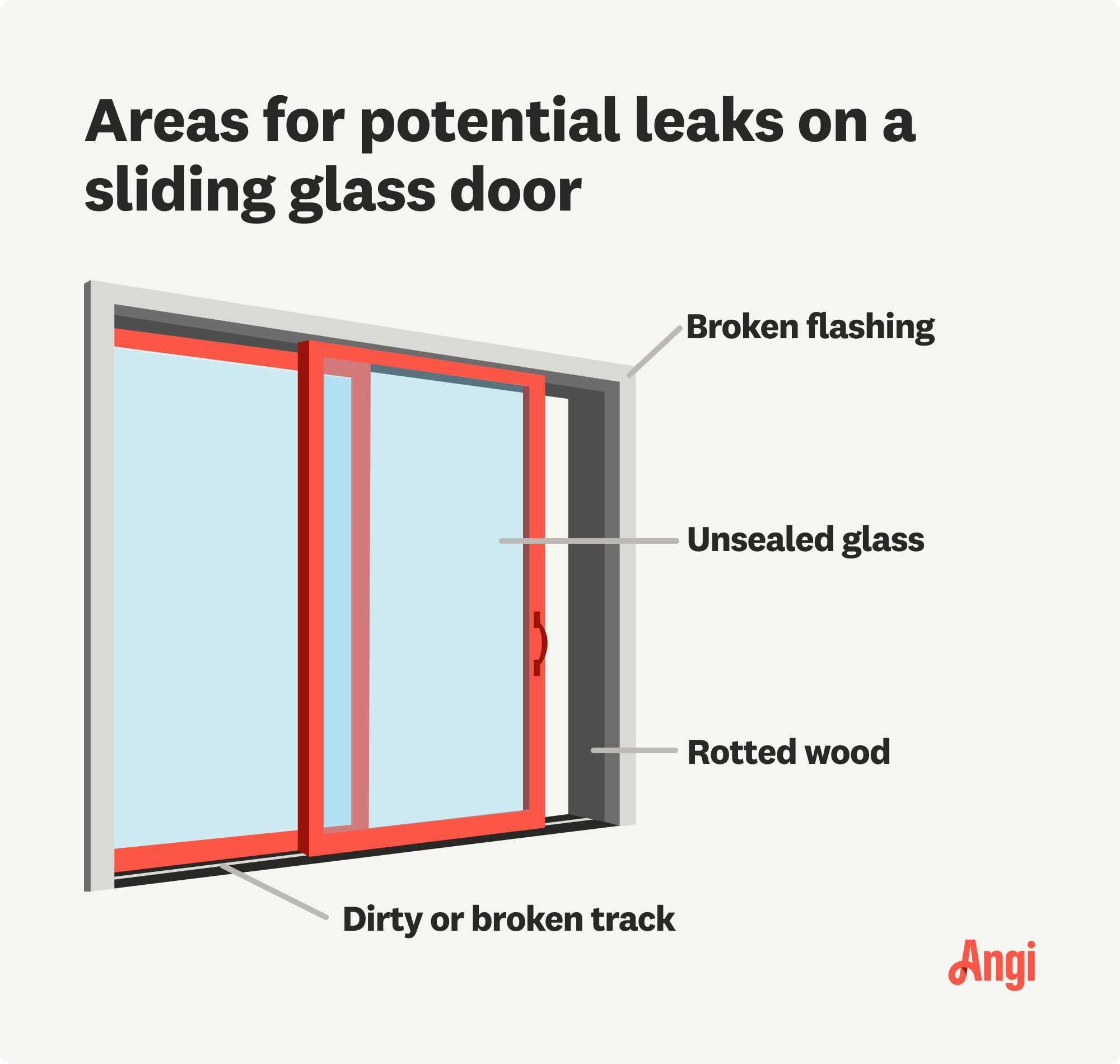Why Water is Leaking Through Your Sliding Glass Door and How to Stop It
Even if your patio sliding door is as secure as Fort Knox, water can still creep in through the track, windows, and framing


Leaks often stem from the door track but can come from several locations.
A dirty or broken track can break the seal between the frame and the door.
Check your rollers, flashing, and weep holes for repairs.
Your glass can become unsealed over time.
Call in the professionals for water cleanup and damage control.
Water leaking through a sliding glass door isn’t a new issue. Leaking sliding doors can result from something simple, like dirt buildup, or improper installation or damage, requiring the aid of a repair specialist. Combine these issues with a pelting rainstorm, tornado, or hurricane, and you have a recipe for a flooded patio door track, small water leaks around the frame, and water damage in your home.
Try not to fret—sliding patio doors may be finicky, but there’s often an easy fix if there’s leaking. Here’s how you can identify the common issues, what to do about them, and who to call for a professional fix.
How to Locate the Leak
Let's say you come home from a long day of work, and there's a pool of water just inside your sliding door. You're not sure where it came from either—was it a leaky window? The track of the door? Or was it even around the top frame?
If it’s not currently raining and you want to stop further leaks in the future, break out the garden hose. Lightly spray the outside of your door and observe where the water breaks through to the inside. If a light mist doesn't do it, add some water to the track. The bottom track is the most common culprit, but it's important to rule out other areas first.
Common Reasons You Have Water Leaking Under Your Patio Door

Whether the hose trick yielded results or not, you can also go spot by spot to check if these common issues are to blame for water leaking under your patio door. We all know that minimizing water damage in your home is the goal at all costs to avoid mold, pests, and structural issues, so a little detective work goes a long way.
These are the most common causes of leaks from sliding doors and what you can do to address them.
| Cause of Leak | How Leak Appears |
|---|---|
| Improper installation | Water seeps through gaps between the door and frame. |
| Dirty track | Water pools or flows along the bottom track of the door. |
| Broken track or rollers | Water leaks along the bottom track of the door, which may slide unevenly or stick. |
| Blocked weep holes | Water accumulates inside the door track or frame. |
| Broken door flashing | Water leaks at the connection of the door and the wall. |
| Unsealed glass | Water drips through gaps in the glass edges. |
| Worn-out weatherstripping | Water seeps through gaps between the door and frame. |
| Rotted wood siding | Water stains and drips from the top of the frame. |
1. The Door Was Installed Incorrectly
If your patio door was installed recently and you notice water pooling around the bottom of your door, it’s possible that the threshold or sill pan was installed incorrectly. If water is coming in through the side of your patio door, you might need additional caulking or reinstalled flashing. When hiring a contractor for your patio door, make sure to find a local door installer that comes with references and a good online reputation.
What to do next: Depending on the issue, you’ll likely need to have parts of your door, or the entire door, reinstalled. Contact sliding glass door companies nearby to assess the situation.
2. The Track Is Dirty
Dirty shoes, muddy paws, and gusts of wind all carry grit, dirt, stones, and everything in between into the tracks of our door. These small particles can build up over time, slowly breaking the seal between the bottom of your sliding door track and the door itself.
Even the smallest separation or misalignment can lead to water intrusion and even lower its security.
What to do next: It’s time to grab your vacuum and clean the sliding doors. Try to remove as much visible frit from the door track as you can. If possible, vacuum around the edge of the stationary door as well. You can also use a simple solution of dish soap and water with a wire brush to break up the remaining grit.
3. The Track or Rollers Are Broken
Do you find yourself dragging the door along its track, especially in one tricky spot that always seems to catch? You may have a broken or dented track breaking the seal with your door and letting water in.
The rollers—which move your door along the track—can also wear over time, further causing the door to drift off its track and cause a leak.
What to do next: The easiest route is to call sliding glass door companies in your area to have them examine the track and rollers. Replacing the rollers or track yourself will cost between $20 and $100, while hiring a pro will cost an extra $75 to $140.
4. Your Weep Holes Are Blocked
Many sliding doors come with built-in protection against misdirected rain. Even if your door is properly installed, rain still naturally blows into the track. Weep holes are actually small slats that allow water to drain from the base of the track without being big enough to let in bugs.
However, these slats can easily become clogged during installation—often with caulking—or clogged from debris.
What to do next: Look up the model number of your sliding door to find details about where your weep holes are located. Check if paint, caulking, or other debris block the water flow and remove it on your own or with the help of a contractor.
5. The Door Flashing Is Broken
The base of your door should have a line of metal flashing that redirects water away from your house. This is particularly necessary if your door sits flush with the ground or patio and water frequently flows past the base. If this flashing becomes dented, it could have trouble draining the water.
You should also have the door flashing above the frame, which acts the same way. If it's improperly installed or bumped by a tree branch at some point, it could send water up against the side of your home and eventually through the frame.
What to do next: It's best to bring in a sliding door specialist to install or replace your door flashing. The piece requires very specific placement, and you may need to adjust surrounding parts to remove or place it.
6. The Glass Is Unsealed
If the hose test sends water creeping through the top or side of your windowpane—instead of around the frame—there's a chance the glass has come unsealed. This can happen over time, after severe weather damage, or even when it is installed improperly.
What to do next: If you recently had the door installed, double-check your warranty for repair requests. If not, call a local glass repair specialist to take a look.
7. You Need Need Weatherstripping
If you're experiencing leaks in the colder months, especially after a snowstorm, adding new weatherstripping can help reinforce your doors. Weatherstripping often only consists of a thick foam tape or a rubber tube that latches onto the bottom of the door.
What to do next: Adding new weatherstripping yourself should only cost between $30 and $100. Calling in a professional to tackle the project will add about $150 for the labor.
8. There’s Wood Rot Around the Door
Rotted wood in the door frame or siding can happen because of prolonged exposure to moisture, leading to decay. One of the tell-tale signs of this problem is water stains or visible deterioration on the siding, which may appear as discolored patches or areas where paint has peeled off.
What to do next: You might not be able to perceive the extent of the damage, which is why it’s best to have a professional come inspect it. They’ll need to remove the rotted wood, install new siding material, and properly seal any gaps or joints.
Repairing vs. Replacing the Sliding Glass Door
Whether you’re better off repairing or replacing your sliding glass door depends on several factors, including the extent of damage, the door’s age, and energy efficiency concerns. If the door has very severe frame damage or you’re finding that you frequently need to make repairs to it, then a replacement is a worthy consideration. You may also want to replace it if the door is very old and/or significantly reduces your home’s energy efficiency. Modern sliding glass doors often have improved insulation and better security than their older counterparts.
When to Call a Pro
Smaller leaks caused by clogs, dirt buildup, or parts that you can easily replace likely won’t need a pro to come fix them. But, in some cases, professional help may be necessary, and it’s best to get the leak fixed as soon as possible to prevent mold growth, structural deterioration, and higher repair costs down the line.
Here are some questions to help you decide if you need a pro:
Is the leak widespread, affecting multiple parts of the door?
Have your previous DIY attempts to fix the leak been unsuccessful?
Is there visible damage to the door frame, walls, or flooring?
Do you have the tools or experience to repair it yourself?
Local water cleanup professionals can also help you both move more quickly and allow you to avoid potentially dangerous water hazards. Handling the damage after the fact may require hardwood floor repair or more extensive water damage restoration services.





- How to Secure a Sliding Glass Door: Full Guide
- 5 Ways To Make Your Front Door Energy Efficient
- 6 Essential Sliding Glass Door Parts and How They Work
- 9 Tips to Make Installing a Pocket Door in Your Home Easy
- How to Fix a Door That Sticks: 5 Different Methods
- How to Insulate a Door
- How to Fix a Gap Between a Storm Door and Frame to Seal Your Home
- How to Secure a Door Without a Lock While You Wait for a Locksmith
- How to Measure for a Storm Door to Get the Perfect Fit
- Garage Door Framing Diagram: Know the Measurements, Parts, and More










